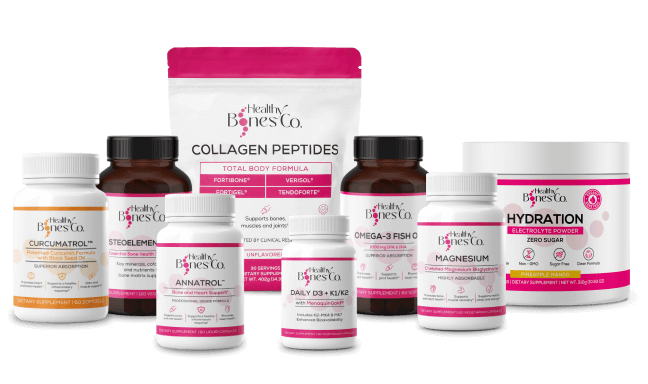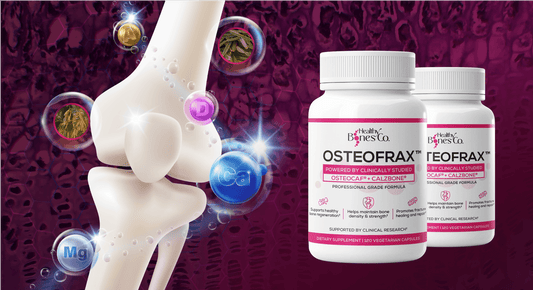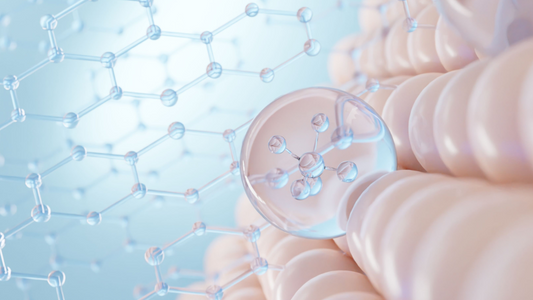Most people often don't think about their bone health until something serious happens—a fracture, chronic back pain, or changes in posture.
But what if there were earlier warning signs you could spot just by looking at your fingernails?
Your fingernails, which you might only notice when they need trimming or painting, could provide important clues about your bone health.
Though it may seem surprising, your nails and bones contain some of the same key nutrients, including essential proteins and minerals that contribute to their strength and structure.
That's why changes in your nails—like increased brittleness, vertical ridges, or slow growth—could be subtle indicators of nutrient deficiencies that also impact bone health.
In this article, we'll examine the connection between fingernail composition and bone density, helping you understand what your nails might reveal about your skeletal health—and how to use that insight as part of a smarter bone health strategy.
The Connection Between Nails and Bones
At first glance, fingernails and bones appear to have little in common. However, these two structures share some key nutrients, which may provide insights into overall bone strength.
Structural Components

Nails are made of keratin—a strong, fibrous protein that gives them durability and protection—while bones depend on collagen, which forms a flexible framework for minerals, ensuring strength and resistance to fractures. (1)(2)
Both proteins undergo specific biochemical modifications, such as sulfation and disulfide bond formation, which are essential for maintaining structural integrity. (3)
A study published in the Journal of Women's Health supports this connection, revealing a potential link between nail structure and bone density, particularly in people with fragile bones. (4)
Researchers compared nails from two groups: those with low bone density and those with healthy bones.
Using nanoindentation to measure brittleness and Raman spectroscopy to analyze disulfide bonds—an indicator of nail strength—researchers discovered that:
- Women with lower bone density have weaker nail structure.
- These women have fewer disulfide bonds in their nails, which are responsible for providing strength and resilience.
The connection becomes clear: nutritional deficiencies and metabolic factors that impact bone collagen formation may also affect nail keratin.
When these important nutrients are lacking, both nail and bone strength can weaken.
Mineral Composition

Just as bones require adequate levels of calcium and magnesium for strength, nails also contain trace amounts of these minerals, suggesting a possible link between nail composition and bone health.
In fact, research from the Journal of Bone and Mineral Metabolism supports this, showing that nail mineral content may reflect overall bone metabolism trends. (5)
In the study, researchers examined nail clippings from 169 women and 115 men, aged 20 to 80, using atomic absorption spectrophotometry.
They found that calcium levels in both fingernails and toenails declined significantly with age, reflecting the gradual loss of bone density over time.
Interestingly, while calcium levels dropped, fingernail magnesium levels tended to increase as people got older.
However, the most compelling finding came when researchers looked at bone density scans; people with higher calcium levels in their nails, particularly in their fingernails, tended to have stronger bones in their lower back.
This was particularly evident in women in their 60s, where both fingernail and toenail calcium levels tracked closely with bone strength.
While nail analysis is not a definitive test for bone health, these findings suggest that nail composition may reflect nutrient status, which can play a role in bone health over time.
Think of your nails as potential indicators of overall nutritional health—changes like increased brittleness, slower growth, or a weaker texture might signal a need to evaluate bone-supporting nutrients.
By recognizing these subtle signs, you and your doctor can assess your health status and take proactive steps, such as optimizing nutrition, to support long-term bone strength.
Nail Signs That May Signal Poor Bone Health
While changes in your nails do not directly indicate bone disease, certain nail characteristics may reflect overall nutrient status, which influences bone health.
Here are some signs to watch out for:
1. Brittle or Weak Nails

Brittle or weak nails that are prone to breaking or splitting easily can sometimes be a subtle sign of nutritional deficiencies that are also important for bone health. (6)
This condition may be related to deficiencies in essential nutrients, such as calcium for bone mineralization and vitamin D for effective calcium absorption. (7)
When the body lacks these nutrients, bone health may suffer over time, as calcium is drawn from the bones to support important bodily functions. This process can also contribute to structural weakness in both bones and nails, making them more fragile and prone to breaking. (8)
2. Ridges or Grooves

While vertical ridges in nails often appear naturally with age, deep ridges—especially horizontal lines known as Beau's lines—are linked to systemic health conditions.
These changes often reflect disruptions in protein synthesis, metabolic function, or collagen production, which are essential for both nail and bone integrity. (9)
Beau’s lines typically occur due to significant illness, malnutrition, or severe physiological stress, which can also impact bone metabolism. (10)
While they do not directly indicate bone loss, they may suggest a period of metabolic disruption that could influence multiple tissues, including nails and bones.
3. Slow Nail Growth

Healthy nails grow steadily at about 3.47 millimeters per month, but slower growth may signal systemic changes affecting both nail and bone health. (11) (12)
Research from Dermatology and Therapy shows that reduced nail growth often accompanies conditions that impact bone health—such as hormonal changes and nutritional deficiencies—as both tissues depend on efficient nutrient delivery and proper mineral balance. (13)
4. White Spots or Discoloration

White spots or patches on nails are commonly caused by minor trauma but can also be linked to zinc and calcium deficiencies—minerals essential for collagen formation and bone metabolism. (14)(15)
As such, these nail changes may be a sign that it’s time to evaluate your nutrient intake to better support both your bone and nail health.
How to Strengthen Both Your Nails and Bones
Healthy nails and strong bones go hand in hand, and the best part is that you can take simple steps to support both. Here’s how to keep them strong and resilient.
1. Balanced Diet

A diet rich in calcium and vitamin D is essential for maintaining both nail and bone strength:
- Calcium: A deficiency in calcium can contribute to brittle nails and may impact bone strength over time. To support bone health, include calcium-rich foods like sockeye salmon (with bones), mackerel, cabbage, chia seeds, and cannellini beans in your diet.
- Vitamin D: Crucial for calcium absorption, vitamin D helps keep both nails and bones strong. Good sources include fatty fish such as salmon, herring, sardines, and anchovies.
2. Healthy Lifestyle Habits

Beyond nutrition, simple lifestyle changes can have a significant impact on strengthening both your nails and bones:
-
Regular Exercise: Weight-bearing exercises like walking, running, and resistance training do more than just strengthen your bones—they also enhance muscle health. Strong muscles provide support to your bones, offering stability and reducing the risk of falls.
Before jumping into any new exercise routine, it’s best to consult with The Bone Coach™ team to ensure your workout routine is both effective and safe.
-
Hydration: Nails are made up of 18% water, while bones contain about 25%, both relying on water to maintain their flexibility and strength. When you’re not drinking enough water, your nails can become brittle and prone to breakage, while your bones may lose flexibility, increasing the risk of damage. (16)(17)
Water is also crucial for transporting essential nutrients throughout your body. It helps deliver calcium and other minerals to your bones, strengthening them while also nourishing your nails. So, drinking enough water each day is an easy and effective way to support both your nails and bones. (18)
3. Fill Nutritional Gaps With Supplements

If dietary intake alone isn’t sufficient to meet your nutritional needs, consider adding supplements, such as calcium and vitamin D, to your diet.
Many calcium supplements come fortified with vitamin D to enhance absorption. This combination is particularly beneficial for maintaining both bone density and nail strength.
On top of that, adding collagen to your daily routine can make a huge difference in strengthening your nails and bones.
Collagen is the foundation of both strong bones and healthy nails. It makes up about 30% of total bone mass and 90% of the organic matrix, providing structure, flexibility, and durability. (19)
Supplementing with collagen peptides can help activate osteoblasts (the cells responsible for building bone) and fibroblasts (the cells that produce collagen), supporting both bone density and nail resilience from the inside out.
This has been supported by multiple studies, including one published in Nutrients.
In the study, researchers worked with 131 postmenopausal women experiencing age-related bone loss to assess the effects of daily collagen peptide supplementation. The participants received 5 g of specific collagen peptides (SCP) daily for 12 months. (20)
They measured bone mineral density (BMD) in the spine and femoral neck, along with blood markers of bone formation (P1NP) and bone breakdown (CTX-1).
The results?
- Participants taking collagen peptides showed increased spinal BMD compared to the placebo group.
- The femoral neck BMD increased by 0.09 g/cm² in the collagen peptide group, while the placebo group experienced a slight decline.
- Bone formation markers (P1NP) significantly increased in the collagen peptide group.
- CTX-1 (a bone breakdown marker) increased in the placebo group, indicating greater bone loss among those not using collagen peptides.
These results suggest that daily collagen peptide supplementation can enhance bone mineral density and support bone formation, making it a promising approach for supporting bone health, particularly in postmenopausal women.
Similarly, a study published in the Journal of Cosmetic Dermatology followed 25 participants who took 2.5 grams of collagen peptides daily for 24 weeks to assess whether it could help with brittle nails and support nail growth. (21)
The participants were given bioactive collagen peptides (VERISOL®) daily, followed by a 4-week off-therapy period.
Doctors monitored nail growth rate, frequency of cracked or chipped nails, and overall clinical improvement in brittle nails.
After 24 weeks, the results showed:
- A 12% increase in nail growth rate.
- A 42% decrease in the frequency of broken nails.
- 64% of participants reported overall improvement in brittle nails.
- 88% of participants maintained improvements even after stopping supplementation.
- 80% of participants felt their nails' appearance had improved.
Since bones and nails share structural similarities, improvements in one can translate to benefits in the other.
Therefore, to support healthy nails and bones, it's important to supplement with collagen peptides.
However, not all collagen peptides are created equal—their effectiveness largely depends on their molecular structure and how easily your body can absorb and utilize them.
In this case, you need to look for bioactive collagen peptides (BCPs).
These specialized peptides are carefully engineered to have the right molecular weight and amino acid sequence that your body can readily use to support both bone and nail health.
So, what makes a high-quality collagen peptide supplement? There are three critical factors to consider:
- First, the collagen should be hydrolyzed, meaning it's broken down into smaller, more digestible pieces that your body can easily absorb and utilize.
- Second, you want type I collagen—the primary form found naturally in both bones and nails. This ensures you're giving your body the exact type of building material it needs.
- Third, look for products backed by clinical research demonstrating their bioavailability—proof that your body can actually absorb and use the collagen effectively.
The good news?
Healthy Bones Co. Collagen Peptides checks all these boxes.
This isn’t your average collagen!
With its carefully formulated bioactive collagen peptides, it’s designed for optimal absorption, ensuring that your body can effectively use it to support both bone and nail health.
What sets it apart is its unique blend of four patented bioactive collagen peptides—FORTIBONE®, FORTIGEL®, VERISOL® (the same as used in the study), and TENDOFORTE®—all with clinically proven benefits for bones, joints, skin, hair, and nails.
-
FORTIBONE®: The only collagen peptide shown in clinical research to help improve bone mineral density and bone formation markers in postmenopausal women.*
-
FORTIGEL®: Helps keep the joints, cartilage, and connective tissue in top shape for pain-free movement.*
-
TENDOFORTE®: Reinforces ligaments and tendons, so you can keep moving without worry.* (only available in Healthy Bones Co. Collagen Peptides pouches).
- VERISOL®: Improves skin elasticity, hair thickness, and nail strength—because looking healthy is part of feeling strong.*
All of this comes with every scoop of Healthy Bones Co. Collagen Peptides, helping you maintain healthy bones, joints, tendons, and ligaments.
But that’s not all—by taking Healthy Bones Co. Collagen Peptides, you also support...
- Skin elasticity, thickness, and hydration*
- Joint tissue health and function involving cartilage, tendons, and ligaments*
- Healthy blood pressure*
- Gut health*
- Better sleep*
Don’t wait for the warning signs. Start building stronger bones and healthier nails today!
=>> Try Health Bones Co. Collagen Peptides today.





